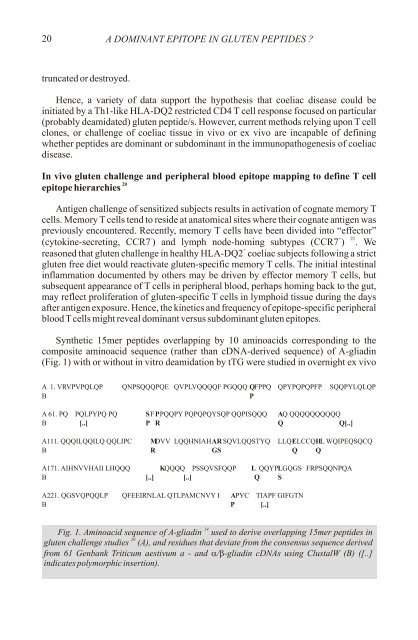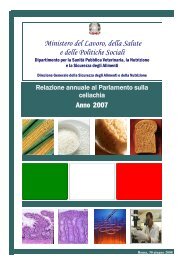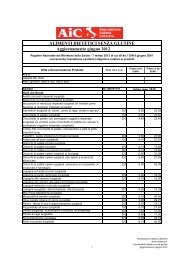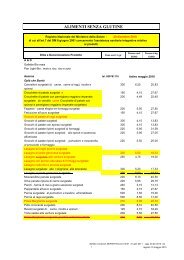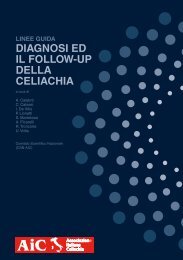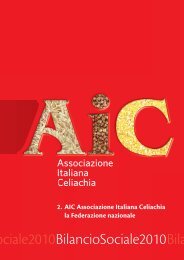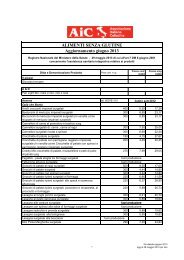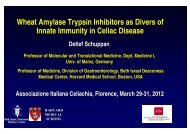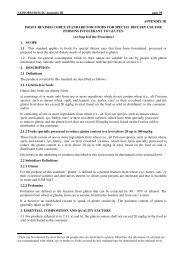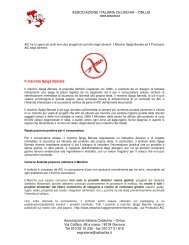primary prevention of coeliac disease - Associazione Italiana ...
primary prevention of coeliac disease - Associazione Italiana ...
primary prevention of coeliac disease - Associazione Italiana ...
Create successful ePaper yourself
Turn your PDF publications into a flip-book with our unique Google optimized e-Paper software.
20 A DOMINANT EPITOPE IN GLUTEN PEPTIDES ?<br />
truncated or destroyed.<br />
Hence, a variety <strong>of</strong> data support the hypothesis that <strong>coeliac</strong> <strong>disease</strong> could be<br />
initiated by a Th1-like HLA-DQ2 restricted CD4 T cell response focused on particular<br />
(probably deamidated) gluten peptide/s. However, current methods relying upon T cell<br />
clones, or challenge <strong>of</strong> <strong>coeliac</strong> tissue in vivo or ex vivo are incapable <strong>of</strong> defining<br />
whether peptides are dominant or subdominant in the immunopathogenesis <strong>of</strong> <strong>coeliac</strong><br />
<strong>disease</strong>.<br />
In vivo gluten challenge and peripheral blood epitope mapping to define T cell<br />
20<br />
epitope hierarchies<br />
Antigen challenge <strong>of</strong> sensitized subjects results in activation <strong>of</strong> cognate memory T<br />
cells. Memory T cells tend to reside at anatomical sites where their cognate antigen was<br />
previously encountered. Recently, memory T cells have been divided into “effector”<br />
- + 21<br />
(cytokine-secreting, CCR7 ) and lymph node-homing subtypes (CCR7 ) . We<br />
+<br />
reasoned that gluten challenge in healthy HLA-DQ2 <strong>coeliac</strong> subjects following a strict<br />
gluten free diet would reactivate gluten-specific memory T cells. The initial intestinal<br />
inflammation documented by others may be driven by effector memory T cells, but<br />
subsequent appearance <strong>of</strong> T cells in peripheral blood, perhaps homing back to the gut,<br />
may reflect proliferation <strong>of</strong> gluten-specific T cells in lymphoid tissue during the days<br />
after antigen exposure. Hence, the kinetics and frequency <strong>of</strong> epitope-specific peripheral<br />
blood T cells might reveal dominant versus subdominant gluten epitopes.<br />
Synthetic 15mer peptides overlapping by 10 aminoacids corresponding to the<br />
composite aminoacid sequence (rather than cDNA-derived sequence) <strong>of</strong> A-gliadin<br />
(Fig. 1) with or without in vitro deamidation by tTG were studied in overnight ex vivo<br />
A 1. VRVPVPQLQP QNPSQQQPQE QVPLVQQQQF PGQQQ QFPPQ QPYPQPQPFP SQQPYLQLQP<br />
B<br />
P<br />
A 61. PQ PQLPYPQ PQ SFPPQQPY PQPQPQYSQP QQPISQQQ AQ QQQQQQQQQQ<br />
B [..] P R Q Q[..]<br />
A111. QQQILQQILQ QQLIPC MDVV LQQHNIAHAR SQVLQQSTYQ LLQELCCQHL WQIPEQSQCQ<br />
B R GS Q Q<br />
A171. AIHNVVHAII LHQQQ KQQQQ PSSQVSFQQP L QQYPLGQGS FRPSQQNPQA<br />
B [..] [..] Q S<br />
A221. QGSVQPQQLP QFEEIRNLAL QTLPAMCNVY I APYC TIAPF GIFGTN<br />
B P [..]<br />
14<br />
Fig. 1. Aminoacid sequence <strong>of</strong> A-gliadin used to derive overlapping 15mer peptides in<br />
20<br />
gluten challenge studies (A), and residues that deviate from the consensus sequence derived<br />
from 61 Genbank Triticum aestivum a - and a/b-gliadin cDNAs using ClustalW (B) ([..]<br />
indicates polymorphic insertion).


